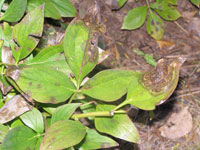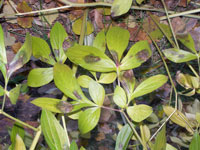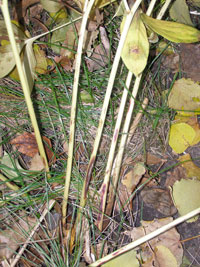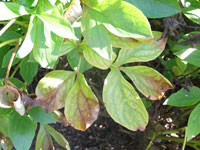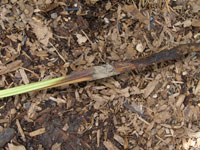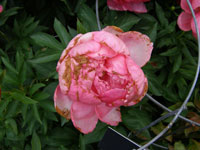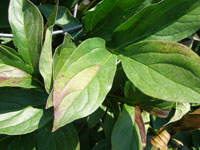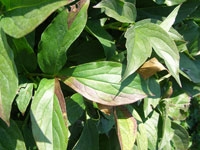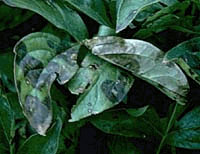Extension > Garden > Diagnose a problem > What's wrong with my plant? > Annuals and Perennials > Peony > Spots on leaves
Peony > Leaves > Spots on leaves
1 of 5
Leaf Blotch (aka Measles)
Cladosporium paeoniae
- 1 inch or larger, irregular to round reddish purple blotches on leaves
- Older leaf spots have dead tan areas with irregular black lines in the center
- Leaves may be curled or twisted near the leaf spot
- In severe cases leaves completely die, but remain attached to the plant
- Red streaks on stems
- Typically seen mid to late summer, after bloom
2 of 5
Gray Mold
Botrytis paeoniae
- New shoots turn black, wilt and die when they emerge in the spring
- Leaves and petals have black to brown irregular spots, and may turn completely black
- Stem infections turn brown or black and often have a target spot appearance
- Flower buds turn black to brown and fail to open
- All infected plant parts produce fluffy gray spores with moisture
- Most common in cool, wet weather
- More information on Gray Mold
3 of 5
Foliar Nematode
Aphelenchoides sp.
- Wedge shaped sections of the leaf turns yellow then reddish-purple
- Purple area of the lea limited by major leaf veins
- Most common late summer to early fall
- Seen of the lower leaves first, but can spread to the entire plant
4 of 5
Virus
Tomato spotted wilt, Tobacco rattle virus and others
- Yellow or light green rings, wavy lines or spots on leaves
- Occasionally dead brown spots on leaves
- Plants may be small, have spidly stalks, and may not flower
- Lab test required to distinguish between viruses and verify infection
- Virus-infected peonies may grow and bloom normally except for the strange patterns on the leaves or other subtle symptoms.
- No treatment is suggested to help cure a virus-infected peony.
- If symptoms are severe, and growth and flowering are greatly reduced, the plant can be removed and discarded.
5 of 5
Phytophora Leaf Blight
Phytophora cactorum
- Black leathery spots on leaves or buds
- New shoots or stems have long sunken black lesions and may fall over
- In severe cases the crown and roots of the plant are soft, wet and mulchy; the entire plant wilts and dies
- Common in heavy, poorly drained soil
- Most severe in wet weather
- Confirmed cases should be removed and destroyed, together with adjacent soil.
- Planting healthy clumps in new locations where the soil is well drained usually prevents further trouble.



